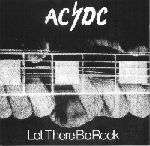Let There Be Rock (song)
| "Let There Be Rock" | ||||
|---|---|---|---|---|
 | ||||
| Single by AC/DC | ||||
| from the album Let There Be Rock | ||||
| B-side | "Problem Child" | |||
| Released | October 1977 | |||
| Format | 7", 12" | |||
| Recorded | 1977, 1976 | |||
| Genre | Hard rock, blues rock | |||
| Length | 6:10 | |||
| Label | ATCO | |||
| Producer(s) | Harry Vanda, George Young | |||
| AC/DC singles chronology | ||||
| ||||
"Let There Be Rock" is a song by Australian hard rock band AC/DC. It is the third and title track of their album Let There Be Rock, released in March 1977, and was written by Angus Young, Malcolm Young, and Bon Scott.
It was also released as a single, with a B-side of "Problem Child", in 1977.
Composition
The song provides an encapsulated, fictionalised version of the history of rock 'n' roll. Building on a line from the Chuck Berry song "Roll Over Beethoven": "... tell Tchaikovsky the news", "Let There Be Rock" reveals that Tchaikovsky did in fact receive the message and subsequently shared it with the masses, resulting in the rise of rock 'n' roll.
Following rock's birth, rock bands appeared everywhere, musicians found fame (while businesses made money off their efforts), and millions of people learned how to play electric guitar. The third and final verse speaks of a "42-decibel" rock band playing good, loud music in an establishment called "The Shaking Hand". This is usually changed to "92-decibel" in live versions of the song. After the final verse, the song ends with an extended solo by Angus Young, which consists mainly of fast picking, string bends, and hammer-ons.
Live recordings
Being one of AC/DC's most popular songs, "Let There Be Rock" has been included on four of the band's six official live albums: If You Want Blood You've Got It (sung by Bon Scott, 1978), Live: 2 CD Collector's Edition (sung by Scott's replacement Brian Johnson, 1992), Let There Be Rock: The Movie (Scott, 1979), released in 1997 as part of the Bonfire box set, Stiff Upper Lip Tour Edition (Johnson, 2001), recorded from Plaza De Toros in Madrid from 1996, and Live At River Plate (Johnson, 2012), with the last recorded during AC/DC's Black Ice World Tour at River Plate Stadium in Buenos Aires on 4 December 2009.
Live performances of the song often go into a section not included on the studio version, with Angus Young performing an extend solo without accompaniment. It is best known for a section in which he plays varying arpeggios starting on B major and ending on E major.
It is the final song played in Let There Be Rock: The Movie and at the immediate conclusion the words "To Bon" appear on the screen. On recent tours, the song has concluded the regular set before the band reappears for encores.
Music video
The music video for "Let There Be Rock" was filmed in July 1977 (see 1977 in music). It was recorded in the Surry Hills Kirk Gallery church, and featured Bon Scott, Angus Young, Malcolm Young, Phil Rudd, and Cliff Williams, who replaced Mark Evans as the band's bassist shortly after the Let There Be Rock album was released. This marked one of Williams' first public appearances with AC/DC. Scott was dressed as a priest and the rest of the band as altar boys, with Angus Young wearing a halo prop on his head. Towards the end of the video it shows Angus, and the rest of the band jamming while he plays the guitar. In an alternate ending of the video, the colors are morphed and the camera zooms in on the stained glass window.[1] According to an interview with the Young brothers, Scott injured himself in the final jump from the podium. In the video and studio recording, Scott also sings the pre-chorus incorrectly, introducing sound before light. This is corrected during live performances of the song.
Appearances in popular culture
"Let There Be Rock" is a playable song in the music video game Rock Band 2. A television advertisement for the game features a man lip syncing to a clip of the song while others are shown playing the game controller instruments in time to the music. In addition, the Live at Donington version is also available in the AC/DC Live: Rock Band Track Pack.
The song was also alluded to in the Drive-By Truckers song of the same name from 2001's Southern Rock Opera. The song specifically mentions Bon Scott, Randy Rhoads, as well as making references to other deceased rock stars such as members of Lynyrd Skynyrd and Phil Lynott of Thin Lizzy fame.
Cover versions
- The Australian punk rock group the Hard-Ons recorded a cover version featuring Henry Rollins on lead vocals, and released it as a single and EP in 1991.
- Deca Loših Muzičara, a Serbian funk rock band, recorded a cover version of the song in 1997.
- Onslaught, an English thrash metal band, recorded a cover version of the song in 1989 for their In Search of Sanity album.
- L.A. Guns covered "Let There Be Rock" on their 2010 album Covered in Guns.
- Foo Fighters have covered the song multiple times on their Sonic Highways World Tour
Personnel
- Bon Scott – lead vocals
- Angus Young – lead guitar
- Malcolm Young – rhythm guitar
- Mark Evans – bass[2]
- Phil Rudd – drums
Production
- Producers: Harry Vanda, George Young
References
- ↑ Video Footage and Liner Notes, Family Jewels 2-Disc DVD Set 2005
- ↑ Saulnier, Jason (30 September 2011). "Mark Evans Interview". Music Legends. Retrieved 6 May 2013.